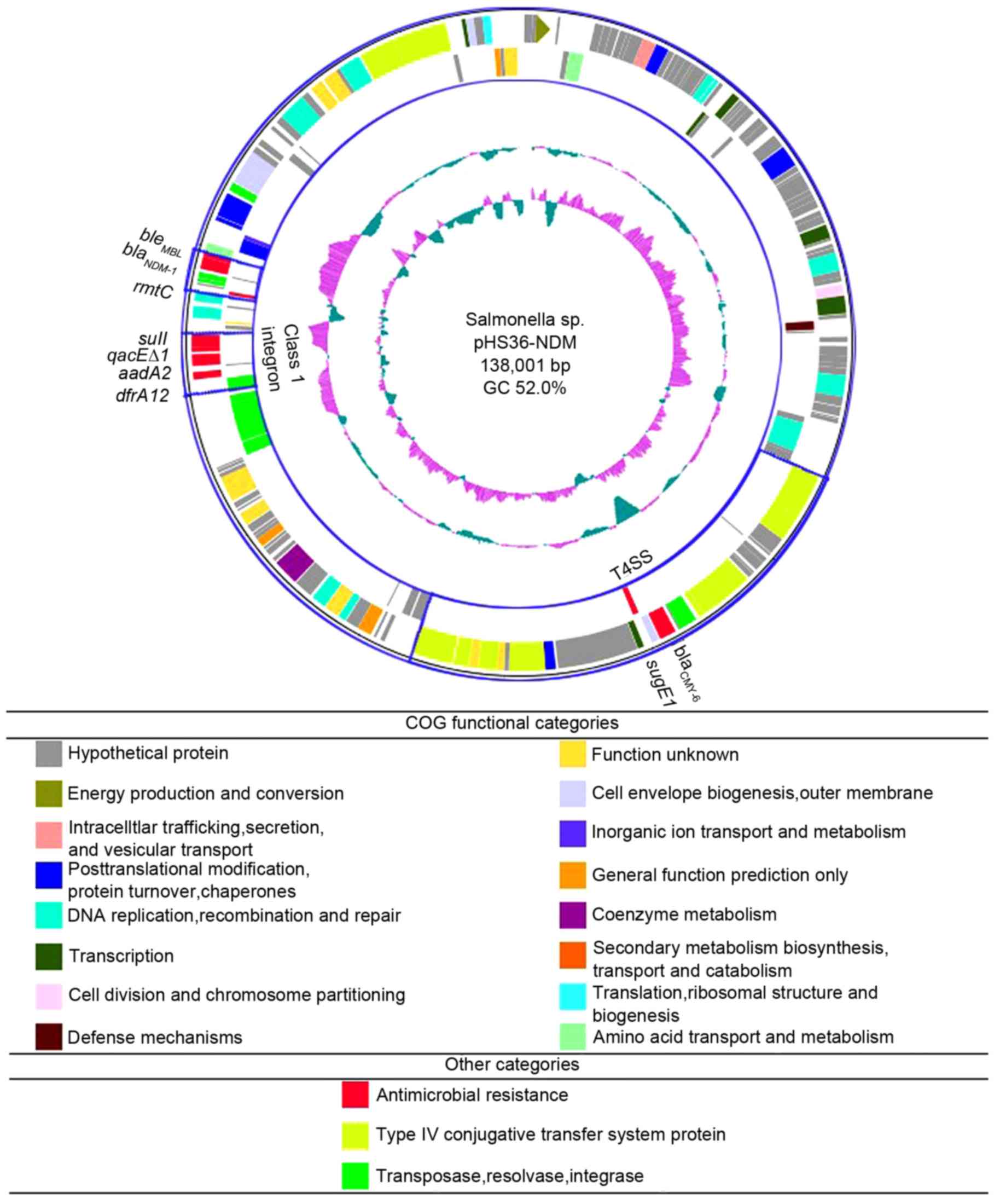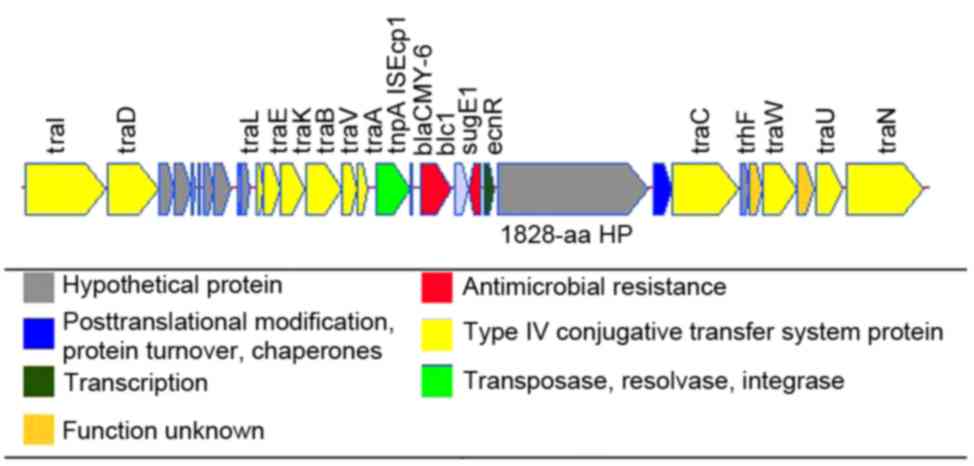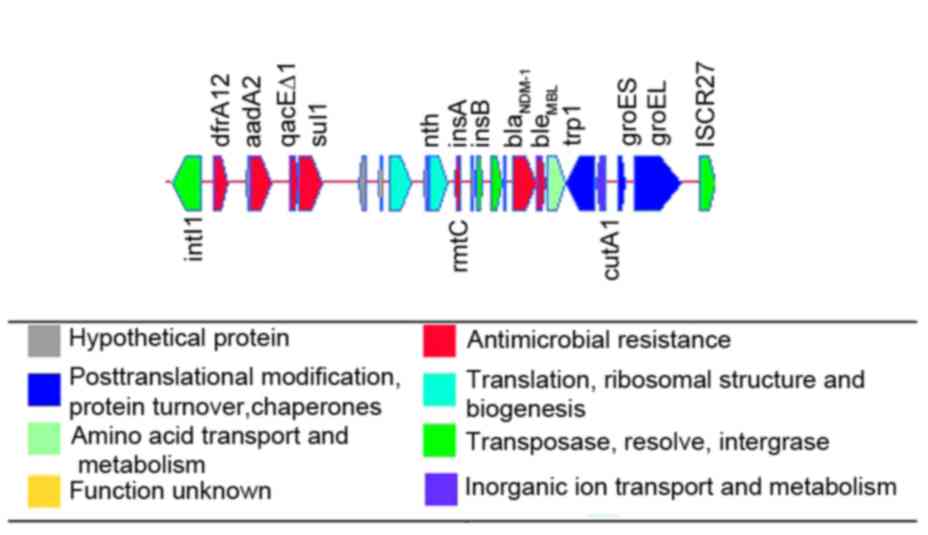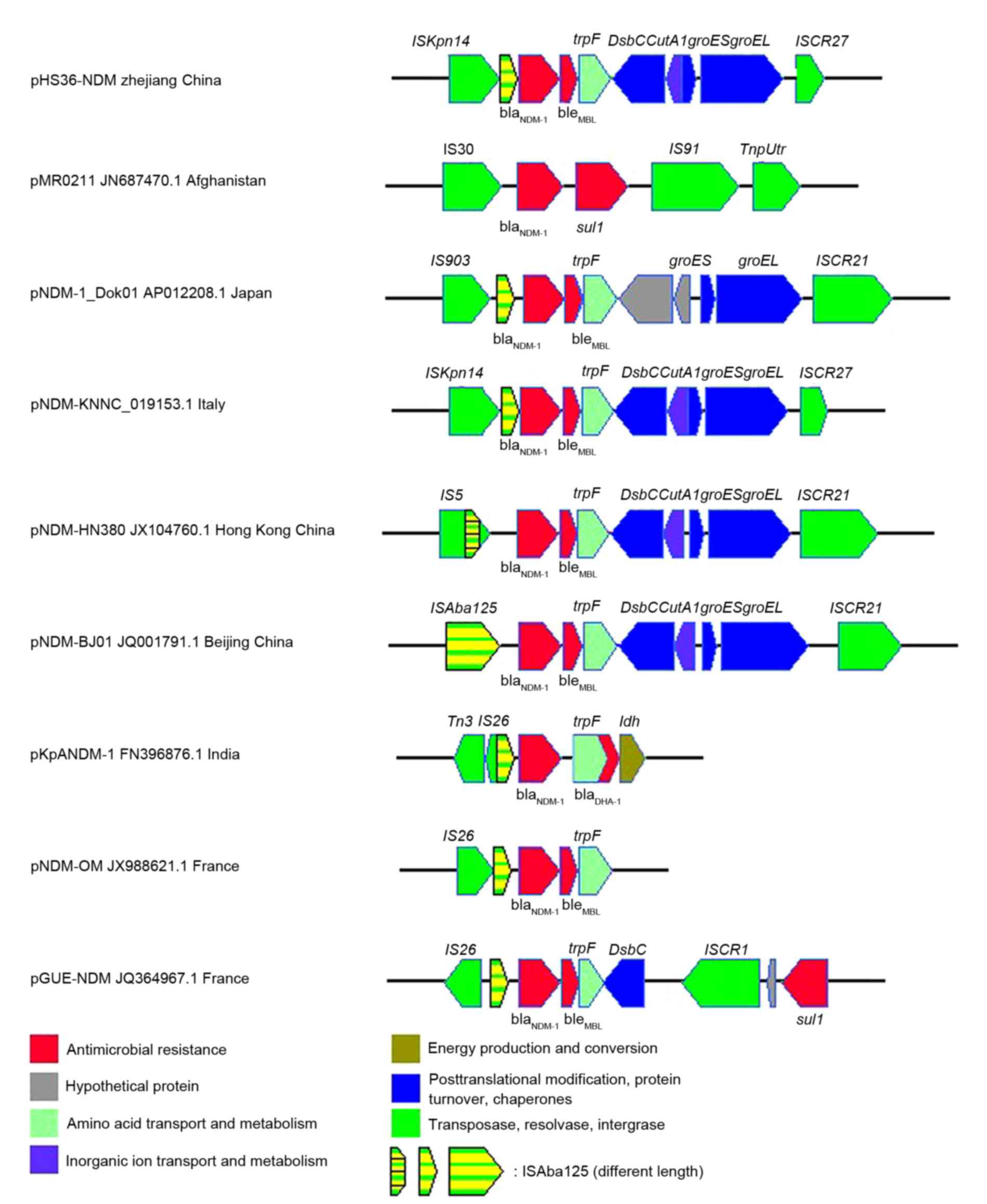|
1
|
Levy SB and Marshall B: Antibacterial
resistance worldwide: Causes, challenges and responses. Nat Med. 10
Suppl 12:S122–S129. 2004. View
Article : Google Scholar : PubMed/NCBI
|
|
2
|
Yong D, Toleman MA, Giske CG, Cho HS,
Sundman K, Lee K and Walsh TR: Characterization of a new
metallo-beta-lactamase gene, bla(NDM-1), and a novel erythromycin
esterase gene carried on a unique genetic structure in Klebsiella
pneumoniae sequence type 14 from India. Antimicrob Agents
Chemother. 53:5046–5054. 2009. View Article : Google Scholar : PubMed/NCBI
|
|
3
|
Sekizuka T, Matsui M, Yamane K, Takeuchi
F, Ohnishi M, Hishinuma A, Arakawa Y and Kuroda M: Complete
sequencing of the bla(NDM-1)-positive IncA/C plasmid from
Escherichia coli ST38 isolate suggests a possible origin from plant
pathogens. PLoS One. 6:e253342011. View Article : Google Scholar : PubMed/NCBI
|
|
4
|
Carattoli A, Villa L, Poirel L, Bonnin RA
and Nordmann P: Evolution of IncA/C blaCMY-2-carrying plasmids by
acquisition of the blaNDM-1 carbapenemase gene. Antimicrob Agents
Chemother. 56:783–786. 2012. View Article : Google Scholar : PubMed/NCBI
|
|
5
|
Lowe CF, Kus JV, Salt N, Callery S, Louie
L, Khan MA, Vearncombe M and Simor AE: Nosocomial transmission of
New Delhi metallo-β-lactamase-1-producing Klebsiella pneumoniae in
Toronto, Canada. Infect Control Hosp Epidemiol. 34:49–55. 2013.
View Article : Google Scholar : PubMed/NCBI
|
|
6
|
Ho PL, Li Z, Lo WU, Cheung YY, Lin CH,
Sham PC, Cheng VC, Ng TK, Que TL and Chow KH: Identification and
characterization of a novel incompatibility group X3 plasmid
carrying bla NDM-1 in Enterobacteriaceae isolates with
epidemiological links to multiple geographical areas in China.
Emerg Microbes Infect. 1:e392012. View Article : Google Scholar : PubMed/NCBI
|
|
7
|
Hu H, Hu Y, Pan Y, Liang H, Wang H, Wang
X, Hao Q, Yang X, Yang X, Xiao X, et al: Novel plasmid and its
variant harboring both a bla(NDM-1) gene and type IV secretion
system in clinical isolates of Acinetobacter lwoffii. Antimicrob
Agents Chemother. 56:1698–1702. 2012. View Article : Google Scholar : PubMed/NCBI
|
|
8
|
Bonnin RA, Nordmann P, Carattoli A and
Poirel L: Comparative genomics of IncL/M-type plasmids: Evolution
by acquisition of resistance genes and insertion sequences.
Antimicrob Agents Chemother. 57:674–676. 2013. View Article : Google Scholar : PubMed/NCBI
|
|
9
|
Bonnin RA, Poirel L, Carattoli A and
Nordmann P: Characterization of an IncFII plasmid encoding NDM-1
from Escherichia coli ST131. PLoS One. 7:e347522012. View Article : Google Scholar : PubMed/NCBI
|
|
10
|
Kumarasamy KK, Toleman MA, Walsh TR,
Bagaria J, Butt F, Balakrishnan R, Chaudhary U, Doumith M, Giske
CG, Irfan S, et al: Emergence of a new antibiotic resistance
mechanism in India, Pakistan, and the UK: A molecular, biological,
and epidemiological study. Lancet Infect Dis. 10:597–602. 2010.
View Article : Google Scholar : PubMed/NCBI
|
|
11
|
Ho PL, Lo WU, Yeung MK, Lin CH, Chow KH,
Ang I, Tong AH, Bao JY, Lok S and Lo JY: Complete sequencing of
pNDM-HK encoding NDM-1 carbapenemase from a multidrug-resistant
Escherichia coli strain isolated in Hong Kong. PLoS One.
6:e179892011. View Article : Google Scholar : PubMed/NCBI
|
|
12
|
Huang J and Wang M, Ding H, Ye M, Hu F,
Guo Q, Xu X and Wang M: New Delhi metallo-β-lactamase-1 in
carbapenem-resistant Salmonella strain, China. Emerg Infect Dis.
19:2049–2051. 2013. View Article : Google Scholar : PubMed/NCBI
|
|
13
|
Chang Y, Luan G, Xu Y, Wang Y, Shen M,
Zhang C, Zheng W, Huang J, Yang J, Jia X and Ling B:
Characterization of carbapenem-resistant Acinetobacter baumannii
isolates in a Chinese teaching hospital. Front Microbiol.
6:9102015. View Article : Google Scholar : PubMed/NCBI
|
|
14
|
Fronzes R, Schäfer E, Wang L, Saibil HR,
Orlova EV and Waksman G: Structure of a type IV secretion system
core complex. Science. 323:266–268. 2009. View Article : Google Scholar : PubMed/NCBI
|
|
15
|
Nazemi A, Mirinargasi M, Merikhi N and
Sharifi SH: Distribution of pathogenic genes aatA, aap, aggR, among
Uropathogenic Escherichia coli (UPEC) and their linkage with StbA
gene. Indian J Microbiol. 51:355–358. 2011. View Article : Google Scholar : PubMed/NCBI
|
|
16
|
Guynet C, Cuevas A, Moncalián G and de la
Cruz F: The stb operon balances the requirements for vegetative
stability and conjugative transfer of plasmid R388. PLoS Genet.
7:e10020732011. View Article : Google Scholar : PubMed/NCBI
|
|
17
|
Del Castillo CS, Hikima J, Jang HB, Nho
SW, Jung TS, Wongtavatchai J, Kondo H, Hirono I, Takeyama H and
Aoki T: Comparative sequence analysis of a multidrug-resistant
plasmid from Aeromonas hydrophila. Antimicrob Agents Chemother.
57:120–129. 2013. View Article : Google Scholar : PubMed/NCBI
|
|
18
|
Call DR, Singer RS, Meng D, Broschat SL,
Orfe LH, Anderson JM, Herndon DR, Kappmeyer LS, Daniels JB and
Besser TE: blaCMY-2-positive IncA/C plasmids from Escherichia coli
and Salmonella enterica are a distinct component of a larger
lineage of plasmids. Antimicrob Agents Chemother. 54:590–596. 2010.
View Article : Google Scholar : PubMed/NCBI
|
|
19
|
Rye HS, Roseman AM, Chen S, Furtak K,
Fenton WA, Saibil HR and Horwich AL: GroEL-GroES cycling: ATP and
nonnative polypeptide direct alternation of folding-active rings.
Cell. 97:325–338. 1999. View Article : Google Scholar : PubMed/NCBI
|
|
20
|
Villa L, Guerra B, Schmoger S, Fischer J,
Helmuth R, Zong Z, García-Fernández A and Carattoli A: IncA/C
plasmid carrying bla(NDM-1), bla(CMY-16), and fosA3 in a salmonella
enterica serovar Corvallis strain isolated from a migratory wild
bird in Germany. Antimicrob Agents Chemother. 59:6597–6600. 2015.
View Article : Google Scholar : PubMed/NCBI
|
|
21
|
Babic A, Berkmen MB, Lee CA and Grossman
AD: Efficient gene transfer in bacterial cell chains. MBio.
2:pii:e00027–e11. 2011. View Article : Google Scholar
|
|
22
|
Wozniak RA and Waldor MK: Integrative and
conjugative elements: Mosaic mobile genetic elements enabling
dynamic lateral gene flow. Nat Rev Microbiol. 8:552–563. 2010.
View Article : Google Scholar : PubMed/NCBI
|
|
23
|
Toleman MA, Spencer J, Jones L and Walsh
TR: blaNDM-1 is a chimera likely constructed in Acinetobacter
baumannii. Antimicrob Agents Chemother. 56:2773–2776. 2012.
View Article : Google Scholar : PubMed/NCBI
|


















